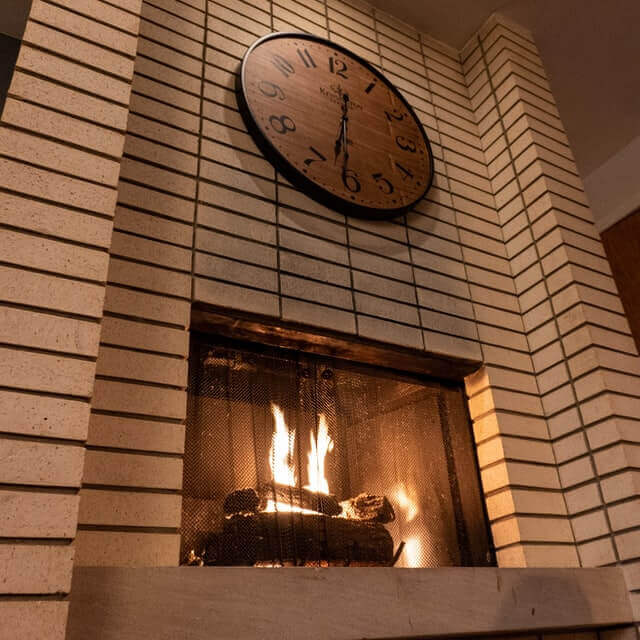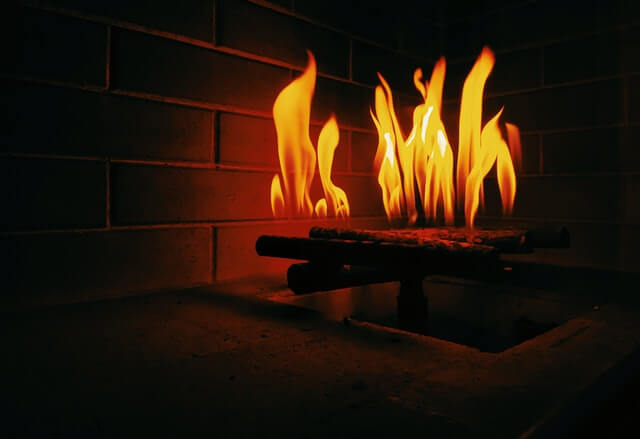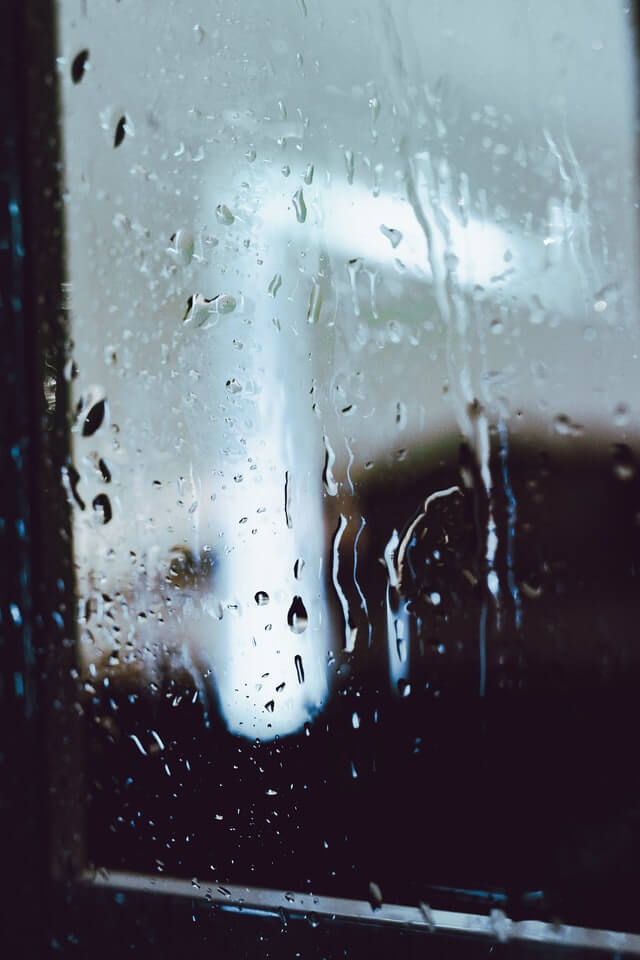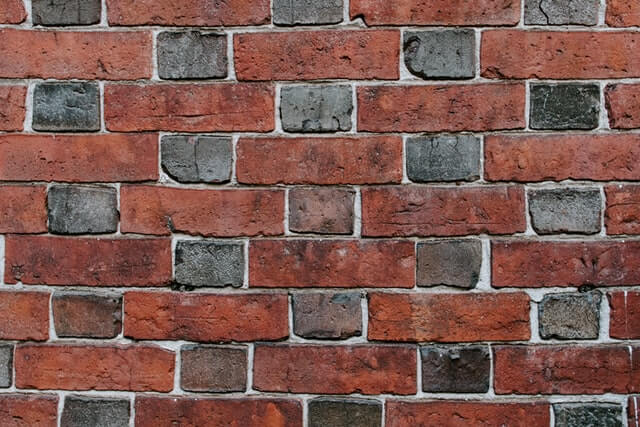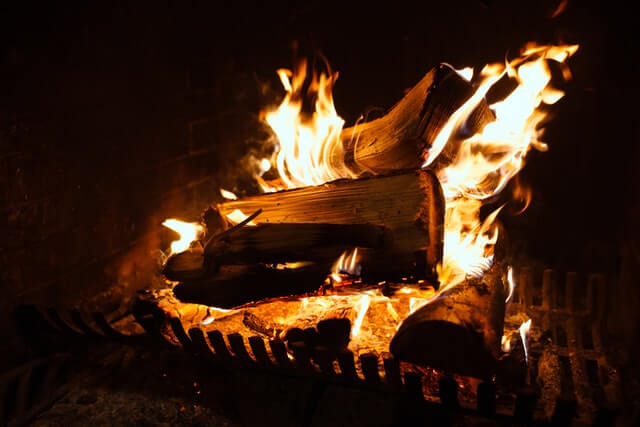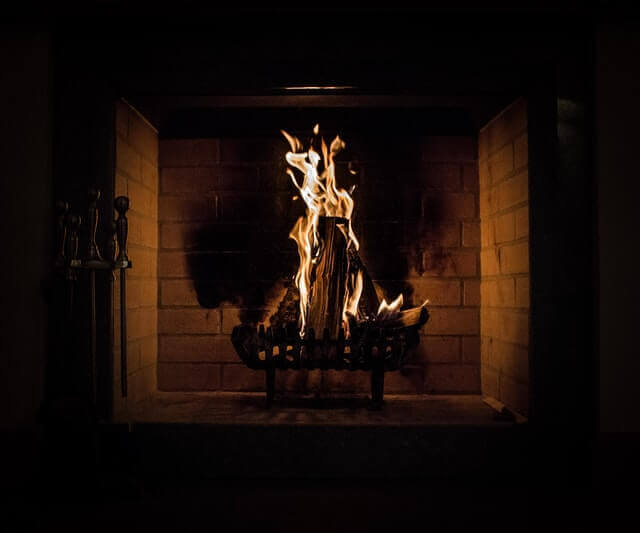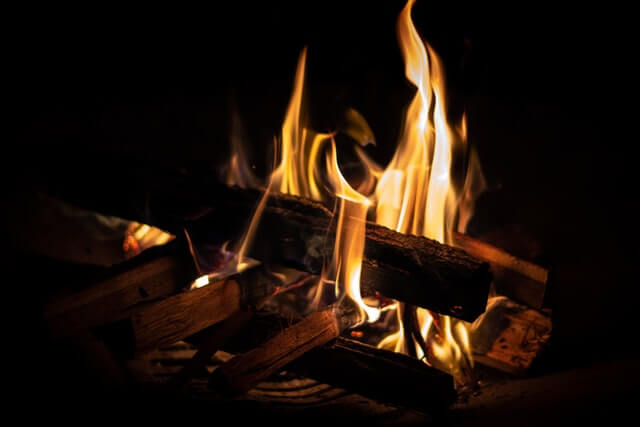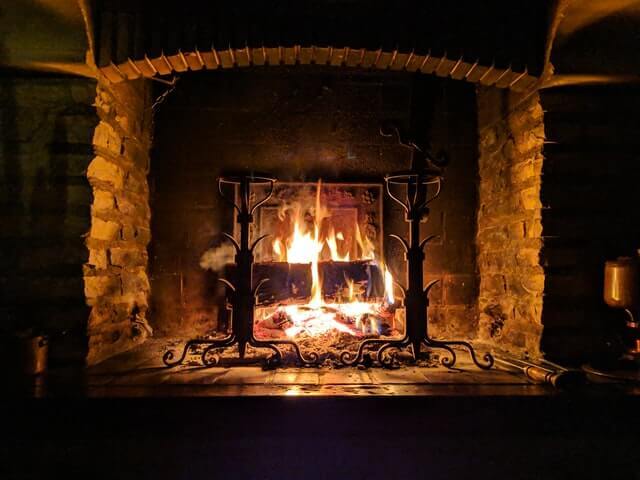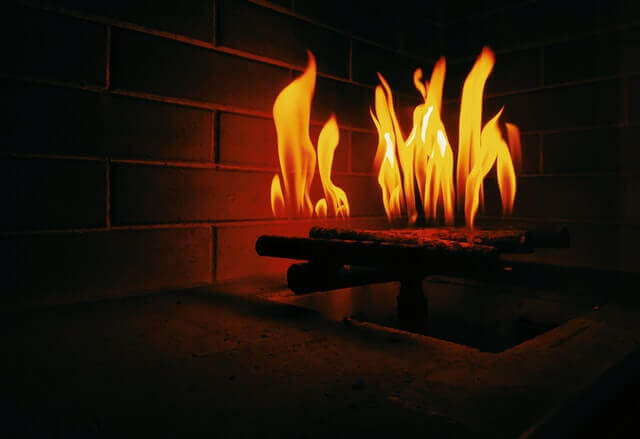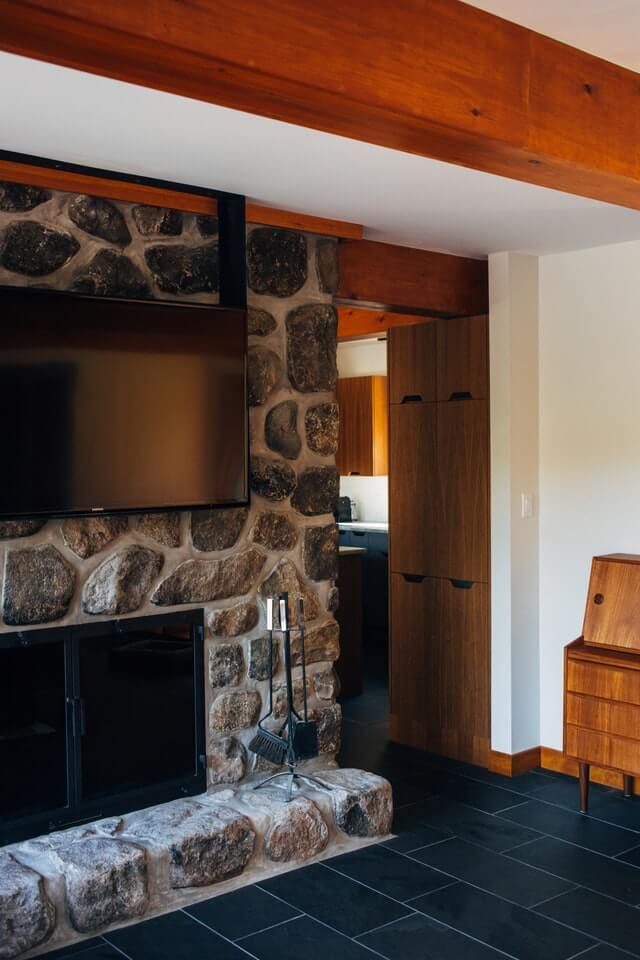How Does A Flue On A Fireplace Work
How does a flue on a fireplace work? Your chimney is one of the most critical components of a Indianapolis home with a fireplace. While it’s not the most glamorous element of your home, it’s important to keep it in excellent condition. To be able to safely enjoy your fireplace, you must understand how your chimney works and how to best care for it.
Today, we’ll review the most important parts of the chimney, including the flue. Read on to find out how a fireplace flue works.
Chimney Types
There are two main types of chimneys, a traditional masonry chimney, and a prefabricated chimney. The traditional chimney includes the firebox and flue. The firebox is where the wood burns and the flue is the air shaft that runs all the way through the roof. On the top of the chimney is a crown that keeps water and critters out of the chimney.
The prefabricated chimney will also have a firebox and a cap, but it will have a simple pipe instead of a flue. These chimneys are less expensive, but also less durable than a traditional chimney. They can also be tough to compare as it’s hard to find the component parts.
The Chimney Damper
Both kinds of chimneys have a damper. The damper is a moveable metal plate that controls the airflow. The damper must be opened to allow the smoke from the firebox to exit through the chimney. When you are not using the fireplace, the damper should be cold to prevent outdoor air from entering your home.
The standard throat damper is installed above the firebox, and controlled by a handle. A top-sealing damper is mounted at the top of the flue and is controlled with a stainless steel chain. The top-sealing damper keeps out animals, debris, precipitation, and outdoor air while keeping the heat inside your home.
Drafting
Drafting is essential for an effective chimney. It’s based on the principle that rising heat creates an air current with an upward trajectory. This principle of convection brings smoke and exhaust out of your home via the chimney. A larger chimney flue can create a stronger draft, but it’s also important to keep the chimney clear of creosote deposits and soot buildup to ensure proper drafting.
Flue Liners
Chimney flue liners are mandatory in some states, but they are critical for your chimney. Flue liners protect your flue, which increases the performance and safety of your chimney. They can protect the combustibles in your chimney, preventing overheating. They also provide a layer of protection against corrosive by-products.
The three types of flue liners available are clay tiles, stainless steel/aluminum, and cast-in-place liners. Clay tiles are often used with masonry chimneys. They are affordable but can crack under intense heat. To remain effective, the clay liner needs to be repaired.
Stainless steel and aluminum liners are commonly used in modern homes. They are easy to install in existing chimneys.
Cast-in-place liners are more expensive because they require extensive labor, but they are formed with heat-resistant concrete. They can be installed on existing chimneys.
Preventing Chimney Fires
The chimney flue must be regularly cleaned and inspected. Creosote, a highly flammable substance, can build up on the flue. Creosote may catch fire and cause a very serious chimney fire that could damage your home and threaten your safety. By simply keeping the chimney flue clean and free from buildup, you can greatly reduce the risk of a chimney fire. Getting your annual chimney sweep and inspection is the easiest way to keep your flue creosote-free and to prevent chimney fires.
A damaged flue is also a hazard for chimney fires. If your flue shows any signs of damage, a professional must repair it. Your yearly chimney sweep and inspection can identify any issues before they become big, expensive problems.
Chimney Repair in Indianapolis
Keep your chimney flue clean and efficient with a chimney sweep and inspection from a professional. For the best chimney services, look no further than your Brick + Ember Outfitters of Indianapolis. We offer affordable, quality chimney cleanings to help you keep your chimney in tip-top shape. Our knowledgeable CSIA-certified chimney technicians will carefully examine your chimney for any signs of damage so we can help you address them fast.
Brick + Ember Outfitters will help you keep your chimney in its prime condition for as long as possible. Whether you need a chimney sweep, repair, or replacement, our team of experts can help. To learn more about our chimney services or to schedule your appointment, contact Brick + Ember Outfitters Indianapolis today at 317-500-1250 or OFFICE@BRICKANDEMBER.COM.
How Do You Stabilize Crumbling Bricks
How do you stabilize crumbling bricks? Whether on the interior or exterior of your home, bricks is a charming material that adds character. It’s an increasingly popular choice for interior walls in Indianapolis homes, as it adds a stunning ambiance and unique feel.
However, brick can also crumble. When it does so, it sheds layers of gritty dust that can quickly overtake your home. Before you panic, try stabilizing any crumbling bricks. With proper stabilization, your brick interior or exterior wall may be able to be preserved.
Today, we’ll review the best ways to stabilize crumbling bricks.
Causes of Crumbling Bricks
There are many reasons for crumbling bricks (known as spalling bricks). Before attempting to stabilize the bricks, you should consider the cause to determine if further action is necessary to prevent more damage later on.
The most common cause of spalling bricks is water. This is usually common in outdoor brick structures that endure the freeze-thaw cycle. Water that gets into the bricks expands when it freezes, then decreases when it thaws. This process puts pressure on the bricks, causing them to crack and spall. While exterior bricks have more exposure to water, this can still happen to interior bricks, and if it does it may signify that water is getting into your home.
Another issue is non-breathable sealants. We will discuss sealing your crumbling bricks to stabilize them, but not all sealants are created equal. Non-breathable sealants do not allow ricks to release any water that gets in, so they will trap the water into the brick.
Low-quality bricks are likely to spall as well, especially when places below the grade level.
Lastly, high-pressure cleaning with water or sand can damage bricks. If your bricks require cleaning, make sure to avoid high-pressure cleaning and opt for a gentler method.
Seal Crumbling Bricks
Sealing your bricks is the best way to stabilize crumbling bricks. It can also be used to prevent spalling, so you don’t have to wait until your bricks are crumbling to do it. While there are many sealants available, you’ll want to be sure to choose a breathable one that does leave a protective film. The key to successfully stabilizing bricks with sealant is proper preparation.
Supplies
- Industrial vacuum cleaners
- Plastic sheeting
- Masking tape
- Drop cloth
- Film-forming masonry sealer
- Roller pain
- Synthetic bristle paintbrush
- Long-nap cover paint roller
- Stiff brush (plastic or copper, not steel).
Clear the Area
You do not want the sealant to get all over your home and items. Move furniture and any other valuables away from the brick wall. Tape off adjacent walls and the floor, covering them with plastic. Place a heavy drop cloth directly below the brick wall.
Prep the Brick
Wipe off any loose brick or mortar with a stiff brush. The best brushes have copper or plastic brushes, as steel-wire brushes may leave black marks. Assess the brick to ensure it’s in good enough condition for sealing. If you notice any severe damage or receding mortar, you will need the help of a professional.
Additionally, any stains on the brick are likely to darken following sealing. To prevent this, you can clean the wall with a mild masonry stain remover or detergent mixture. Rinse it thoroughly and allow the brick to dry completely before moving on.
Remove Dust
Make sure the area is dust-free, so you do not seal any dust or grit to the surface. Vacuum the surrounding area and the wall.
Apply the Sealer
Use a long-nap roller to apply the sealer. Use a synthetic bristle brush to work the sealant into the joints and small crevices. The number of coats and dry time will depend on the manufacturer’s instructions. Let the sealer try completely before moving your stuff back and or subjecting it to any moisture.
Make sure you have proper ventilation while applying the sealer. Even sealers labeled as environmentally friendly require ventilation to safely apply. The need for ventilation makes this project ideal in the summer. If you must do it during colder months, use fans, turn on your furnace fan and crack a window in the room.
Brick Repair in Indianapolis
Mildly crumbling bricks can often be stabilized with a sealer, but more serious spalling cannot be handled with DIY methods. Additionally, sealing your bricks will not address the underlying cause. If you believe serious water damage is the cause, you need the help of a professional.
The team at the Brick + Ember Outfitters of Indianapolis is here to help you with your masonry needs. We can assess your brick structures and determine the best course of action. We’ll let you know if a sealant can do the trick or if you’ll need some more advanced brick repair to deal with crumbling. No matter what your brick needs are, you can count on Brick + Ember Outfitters to provide an affordable solution. To learn more about our masonry services or schedule your appointment, contact Brick + Ember Outfitters today at 317-500-1250 or OFFICE@BRICKANDEMBER.COM.
The Cause Of A Chimney Leaking Water
The cause of a chimney leaking water. While Indianapolis isn’t known for intense rainfall, some seasons present more moisture than others. When it does rain, it’s important to evaluate how your house responds.
Do you notice any raindrops hitting the bottom of your fireplace?
This may seem normal, as your fireplace extends out of the roof of your roof, but any moisture getting into your home from your chimney is a sign of a problem.
Over time, water can cause even more damage if left untreated. Don’t wait until the problem gets bigger, find out why water is entering your chimney as soon as you notice it.
Reasons for Leaky Chimneys
If you’re wondering “is it normal for water to come down the chimney?” the answer is a resounding NO!
Water should not enter your chimney. If you notice water in your fireplace this suggests there may be an issue with your chimney. Some of the most common reasons for leaking chimneys are:
Structural Damage
Your chimney is exposed to the elements all year long. In Indianapolis, that means your chimney faces rain, harsh winter weather, hot summer days, wind, and more. Eventually, the wear and tear of elements (or any natural disasters) can damage the chimney. One common form of damage is cracks or chips between the chimney bricks. While the cracks may not seem like a huge deal, cracks in the chimney’s structure can allow water in. Additionally, the winter freeze-thaw cycle can only make the cracks worse. When water gets in and freezes, it expands the crack, which makes it larger.
Damage to the Chimney Crown
Another common reason for chimney leaks is damage to the chimney crown. The crown sits on top of your chimney and works as a hat to keep rain from entering through the hole at the top of your chimney. The crown has a sloped surface to help rain runoff and away from the chimney.
Cracked, corrosion, or chips in the chimney crown can be a problem for water flow. A damaged chimney crown may allow water into your chimney flue. You’ll most likely notice an issue with the chimney crown during heavy rainfall.
Chimney Lining Issues
Your chimney lining is inside the flue. It helps protect your chimney flue from the extreme heat of fires, as well as corrosive creosote and soot. The chimney lining should also keep water out of the chimney.
Clay liners were popularly used in older Indianapolis homes. However, clay liners are prone to cracking and chipping. If your clay liner is damaged, it will need to be replaced to protect your flue.
If you deal with dripping water during rainfall, replacing your chimney liner can help resolve the issue. During the chimney lining replacement, the professionals can also resolve any other small signs of damage they may notice in your chimney.
Leaking Roof
A leaky roof can also cause water to enter your chimney. If the roof is damaged near the chimney, it will allow water in. roof flashings are meant to keep rainfall out, but over time they may sustain damage. If the flashings around your chimney show any signs of damage, they may be letting water into your fireplace, but it’s also likely that water could be getting into the roof bed or attic as well.
How to Fix a Leaky Chimney
Water entering your home is not normal, even if it’s coming from your chimney. A structurally sound chimney will be able to keep rainfall and elements out of your home. If you notice any water entering through your chimney, address it as soon as possible to prevent more serious damage to your home.
First and foremost, you must figure out how the water is getting in. For an untrained eye, it will be very hard to inspect the roof or chimney accurately. Instead, consult your local experts, the Brick + Ember Outfitters of Indianapolis. We will inspect your chimney carefully to determine the cause of the leak.
After we’ve found the source of the leak, our knowledgeable team can correct it. We will do everything we can to preserve as much of your chimney as possible, opting for repairs over replacement when possible. We’ll explain how the repair will help. The sooner you address a leaking chimney, the quicker we can repair it. Fast action is the key to preventing more extensive problems down the road.
If water is coming down your chimney, now is the time to find out why and get it fixed. Our team of CSIA certified chimney specialists will analyze and address your chimney problems quickly and efficiently. To learn more about our chimney services or to schedule your appointment today, contact Brick + Ember Outfitters at 317.500.1250 or office@brickandember.com.
Can Cracked Bricks be Repaired? The Elements of Masonry Repair.
Can cracked bricks be repaired? The elements of masonry repair. Brick adds a charming element to any Indianapolis home. In older homes, it was used for external walls, but even newer Indianapolis homes may include brick chimneys or other features. There’s no doubt about the beauty of brick, but like any material, it faces wear over time.
Extreme weather, stress on the wall, and other factors can lead to cracked bricks. Cracked bricks are unsightly, and can lead to further deterioration of your masonry structure. It’s important to address cracked bricks as soon as possible, but the good news is that most can be repaired.
Repairing Cracked Bricks
Most cracked bricks can be repaired. By patching cracked bricks with new mortar, you can restore the look of your masonry structure. However, you’ll want to use a mortar that matches the color of your bricks so that it’s not noticeable. Repairing cracked bricks is often doable, it just takes some time and planning.
Steps to Repairing Cracked Bricks
Here’s the basic process for repairing your cracked bricks:
- Gather safety supplies. You’ll need safety goggles, work gloves, and a dust mask.
- Remove any loose brick pieces. It may be possible to glue on larger pieces, so save them.
- Use a chisel and hammer to remove any cracked mortar. Place the chisel end near the center of the damaged mortar, and then tap the other end with the hammer to loosen it. You must remove the old mortar for the new mortar to stick.
- Clear our dirt and dust from the cracks using a stiff-bristle brush.
- Mix your new mortar. Combine 3 parts of sand with 1 part of mortar.
- Combine the sand and water until it’s a runny paste consistency. If the mortar is too thick, slowly add small amounts of water and mix until it reaches that consistency.
- Add mortar dye to create a color that is slightly darker than your bricks. If you are also repairing your mortar joints, create a separate mix without dye.
- Apply the mortar to the brick cracks using a trowel. Put uncolored mortar into the joints if you have to also repoint some joints. Pack the mortar in tightly and then feather it out to be level with the brick faces. In some cases, you may need a tool to shape the mortar to match the existing joints.
- If you had any large brick chips, press them into the mortar to further hide the cracks.
- Allow the mortar to set for two hours. To remove excess mortar, press a damp sponge onto the brick surface.
- The mortar will need 24-48 hours to fully cure.
Should I repair my own cracked bricks?
Sometimes, at-home brick repair may be perfectly suitable. If you have very few cracks and the cracks are small, it may be easy enough to repair them at home. However, keep in mind that you’ll need the correct safety equipment, tools, and supplies. If you plan to repair cracked bricks at home, do not skimp on the tools or process. You must dedicate the time and follow the directions to successfully complete the cracked brick repair.
In some cases, you should consult an expert. Even if you do have minor cracks, time is a factor. When you hire a professional to handle cracked brick repair, you can dedicate your time to other important tasks you have to do. Additionally, an expert can perform the job much quicker than someone who has never done it before.
If you have extensive cracked bricks and mortar, then it’s also a good idea to leave it to the professionals. DIY cracked brick repair and masonry repair sounds simple in theory, but once you get into the job you will realize that it can be messier, more time-consuming, and more complicated than it sounds. For example, it may sound easy to apply the mortar but it requires a certain technique for a successful application.
When deciding if you should attempt your own masonry repair, consider the time, expense of tools/equipment, and complexity of the damage.
The Best Masonry Contractors in Indianapolis
Masonry repair is a serious process that you want to be done right. Unprofessional masonry repair can provide a temporary fix, but it typically won’t hold up as long as brick repair done by an expert. No matter what kind of masonry damage you notice, the dedicated team at Brick + Ember Outfitters of Indianapolis is here to help.
Our experienced team will assess the condition of your masonry and determine the best course of action for masonry repair. Whether it’s as simple as cracked brick repair or as extensive as a replacement, you can count on our team to do the job right. To learn more about our masonry repair services or to schedule an appointment, contact Brick + Ember Outfitters today at 317-500-1250 or OFFICE@BRICKANDEMBER.COM.
Step by Step Approach to a Wood Burning Fireplace Installation
Step by step approach to a wood burning fireplace installation Fireplaces are excellent additions to Indianapolis homes because of the warmth and comfort they provide. There’s nothing quite as cozy as snuggling up in front of the fireplace during the cold Indiana winters. However, not all homes came with a fireplace.
That leads many homebuyers and homeowners to ask, “can you install a wood-burning fireplace in an existing home?”
Fortunately, the answer is almost always YES!
A traditional wood-burning fireplace can be added to most existing homes with the right knowledge and preparation.
Here’s what you need to know about installing a wood-burning fireplace in an existing home.
Benefits of Adding a Fireplace to a Home
Fireplaces offer many important benefits for Indianapolis homeowners. Here are some reasons you may want to consider adding one to your home:
- Create a cozy ambiance.
- Add warmth to your home, especially during fall and winter.
- Improve the look of your home.
- Increase the value of your home.
- Fireplaces are sought-after features that many homebuyers look for. Adding one may help you appeal to buyers when you choose to sell.
Adding a Fireplace to an Existing Home
It’s often possible to add a fireplace to a home that’s already built. However, you must decide which fireplace works best. Check the local building codes and requirements for vent pipes and emissions. The common types of fireplaces to choose from are prefabricated, gas, wood-burning, or electric.
Direct-Vent Gas Fireplaces
Direct-gas fireplaces are the easiest to install, as they can be installed on any exterior wall. The vent simply faces out the back of the wall. Installation is fast, only taking a day or two. Now, you won’t get the traditional “fireplace feel”, like the crackling and smoldering wood scents from a wood-burning fireplace, but you’ll still be able to set a cozy mood. Direct-vent gas fireplaces are a great choice for supplying warmth, and they are easy to operate and maintain.
Wood-Burning Fireplaces
Wood-burning fireplaces offer a traditional, nostalgic fireplace look and feel. However, to add a wood-burning fireplace, you must have enough space to create a chimney through the roof. This is often easier for one-story homes, and the options can be limited for multi-story homes. Still, you can often find enough space to add a chimney by enclosing a spare closet or corner of a room. While this type of fireplace is highly sought-after, it will cost the most. It’s typically crafted from brick or stone and a wood mantel.
Factory-Built Fireplace
Perhaps the most affordable option is a zero-clearance/ factory-built fireplace. These sleek, modern fireplaces are lightweight and offer linear designs. They’re very easy to install and don’t require nearly as much construction as a wood fireplace. They’re also very easy to maintain, and they can be installed in any room thanks to their firebox enclosures.
Deciding Where to Put a New Fireplace
You’ll also need to factor in where to put your fireplace. Most people enjoy putting their new fireplace in a common room, like the living room or family room. However, there are other options. If you want efficient heating, then you may want to put the fireplace in a smaller room. Some other popular options are the office, spare bedroom, or master bedroom.
When determining the location of your fireplace, you’ll have to consider the size of the firebox, the type of chimney/liner, and the size of the damper opening. Make sure to review your local building codes.
The Cost of Fireplace Installation
It’s certainly easier to add a fireplace into a new build, but it’s possible to do for existing homes. Of course, fireplace installation is an investment. So the big question is how much does it cost to put in a fireplace?
The average cost of a new prefabricated gas or wood fireplace is around $2,900, according to HomeGuide. On the other hand, an electric fireplace costs about $1,200. A masonry fireplace is most expensive, costing around $4,900.
The prices above are simply averages, which offer a rough idea of the cost. However, every fireplace installation is unique. The exact cost will depend on several factors, and the only way to get an accurate estimate is to speak with a fireplace installer. The knowledgeable team at the Brick + Ember Outfitters of Indianapolis are happy to discuss your fireplace needs and provide you with an accurate estimate.
For the best fireplace installation services in Indianapolis, look no further than B+E. We are here to help with all of your fireplace needs, including design, installation, maintenance, and repairs. To learn more about our fireplace services or to schedule an appointment for your fireplace installation quote, contact Brick + Ember Outfitters today at 317-500-1250 or OFFICE@BRICKANDEMBER.COM.
How Much Does it Cost to Install Gas Logs?
How Much Does it Cost to Install Gas Logs?
How much does it cost to install gas logs? Gas fireplaces are easy to use and maintain, which is why they are such a popular choice for modern Indianapolis homeowners. Whether installing a new fireplace or converting an old one, many homeowners are considering a gas log fireplace.
Can You Vacuum Ash From a Fireplace?
Can you vacuum ash from a fireplace? Cleaning the ash from your firebox is an important part of fireplace maintenance. While it’s not incredibly difficult to clean ash from the fireplace, it can be a bit messy and time consuming, which leads many homeowners to wonder if they can use their vacuum cleaner to remove ash from the fireplace.
Today, we’ll address the common question “can you vacuum ash from a fireplace?” and provide more information on cleaning out ash from your fireplace.
Why Do I Need to Clean Ash?
While it’s okay to have some ash in your fireplace, you do not want a huge pile of it. For one, ash is very acidic, which can damage the fireplace. As warmer months approach, ashes can draw in moisture and destroy your fireplace, leading to costly repairs. Ash is also an allergen, much like household dust, and it can get into your home when you leave it in your fireplace.
Generally, it’s much easier to remove a little ash on a regular basis, rather than letting it all build up. Throughout the burning season, you will not have to fully remove every piece of ash. During the burning season, you can leave a 1-2 inch layer of ash to assist with combustion and help burn a better fire. However, come spring you should thoroughly clean the ash and wipe down your fireplace.
Household Vacuums Cannot Clean Ash
If you’re wondering whether or not you can use your household vacuum cleaner to remove ash from your fireplace, the answer is no. household vacuums are not designed to handle ash removal, and using them for that purpose can result in some problems.
If you try to use your personal vacuum cleaner to remove ash, you may damage your machine. Hot embers can lurk beneath the ash, and they can damage your vacuum cleaner if you use it to suck up the ash. Worse yet, a fire could start inside the vacuum collection area.
Additionally, the vacuum cleaner will not be able to keep the ash from getting into your home. Ash particles are much smaller than typical household dust, so it can slip through your vacuum’s filter. Ash dust is not good to breathe in, which is why you will need to wear a mask and protective eyewear when working with it.
Ash Vacuums
While you cannot use a normal household vacuum to clean the ash from your fireplace, you can use a vacuum designed for ash. PowerSmith, Vacmaster, Stanley, and Snow Joe all sell ash vacuums that you can buy. Ash vacuums are smaller than household vacuums, and specially designed for cleaning ash from your fireplace.
While the prices vary, you don’t have to break the bank to get a good quality ash vacuum. There are many options available for less than $200, and you can purchase any accessories you need for cleaning your garage or other areas.
The main difference between a household vacuum and ash vacuum is the metal holder container that ash vacuums have. The metal canister can contain the heat from any burning embers, and ash vacuums also have heat-resistant hoses. This type of vacuum cleaner includes specialized filters that can trap fine ash particles and keep them out of your air.
How to Clean Ash from Your Fireplace
Cleaning the ashes from your fireplace is important for fireplace maintenance and fire safety, but you must be careful. You want to make sure the ashes are cool before attempting to clean them. Here are some tips for cleaning ashes from your firebox:
- Wait 12 hours or more after the last fire.
- Examine the firebox for live embers. If there are any hot embers, extinguish or remove them.
- Use a metal shovel to scoop out ash. Place the ash in a metal bucket, and place the bucket outside and away from combustible materials.
- Vacuum the rest of the remaining ashes with an ash vacuum.
- Use a sponge with soap and water to clean the inside of the surfaces. Try a scrub brush for any stubborn areas.
- Rinse, then wipe down, all of the surfaces.
Get Help with Fireplace Ash
Whether you need help with your fireplace ash or another chimney and fireplace service, your Brick + Ember Outfitters of Indianapolis are here to help. With a full chimney sweep and inspection, we can clean your chimney and fireplace to prepare it for next season. We’ll make sure your fireplace and chimney are in great shape, and help prevent damage from ash, soot, and smoke. To learn more about our chimney and fireplace services or to schedule your appointment, contact Brick + Ember Outfitters today at 317-500-1250 or OFFICE@BRICKANDEMBER.COM.
What Tools Do Chimney Sweeps Use?
What tools do chimney sweeps use? Clean chimneys are safe, efficient chimneys. It’s best practice to get an annual chimney sweep and inspection. A professional chimney sweep and inspection is a minuscule expense compared to the cost of dealing with a chimney fire or the other problems that may arise from a dirty chimney. However, many Indianapolis homeowners are looking to save money and consider trying their own chimney cleaning or finding a “chimney sweep” that’s offering a dangerously low price. In reality, it’s best to rely on the expertise and tools of a professional chimney sweep.
What Can I Use for a Fireplace Hearth?
What can I use for a fireplace hearth? The fireplace hearth plays a huge role in the aesthetics of your fireplace, but it’s also important for safety. Whether remodeling or installing a fireplace in your Indianapolis home, it’s important to select the right fireplace hearth for your space.
Does a Gas Fireplace Need to Be Cleaned?
Does a gas fireplace need to be cleaned? Most Indianapolis homeowners understand that a wood-burning fireplace must be cleaned yearly, many still raise questions about the cleaning needs of a gas fireplace. Since gas fireplaces burn natural gas or propane, it’s not always clear if they produce the same creosote as a fireplace that burns wood.
Gas fireplaces don’t produce creosote or other byproducts as wood. However, they still need a yearly fireplace sweep and inspection. Here’s why.
Remove Other Buildup
A primary function of a chimney cleaning is to remove creosote buildup, which reduces the hazard of a chimney fire. However, chimney sweeps have several other important functions. For one, they remove other forms of buildup. A gas fireplace may still attract debris, birds’ nests, critters, or soot into the chimney. A yearly chimney sweep will also remove those other forms of buildup that could cause serious problems if unaddressed.
Spot Issues Early
The other important purpose of a chimney sweep is to spot any issues. Modern chimney sweeps include a detailed inspection as well. The sooner a problem with your chimney or fireplace is addressed, the quicker it can be handled. Repairing any minor issues will prevent them from becoming big, expensive fixes later down the road. Your annual chimney sweep and inspection can help you find and address any minor issues, meaning you can repair them for much less than you would if they continued to get worse.
Replace Worn Parts
Gas fireplaces contain several important components that must be kept in good condition. Over time, the parts will sustain wear and require replacement. The annual inspection looks for damage to your chimney and fire, but it will also catch any worn parts. During your chimney sweep and inspection, the expert can examine your ceramic logs, hoses, couplings, valves, and other components to determine any need for replacement.
Inspect Gas Leaks
Gas leaks are one hazard of a gas fireplace. Even slight damage to a valve can cause a gas leak, which can lead to an explosion if left unaddressed. Your chimney sweep and inspection is the perfect time to inspect for gas leaks and prevent a disaster later down the road.
How often do I need a professional chimney sweep on a gas fireplace?
Gas fireplaces require less upkeep, but maintenance like a chimney sweep is still very important. Gas fireplaces still require an annual chimney sweep and inspection. Regular fireplace users should get a chimney sweep at least once a year, even if the fireplace is gas.
What to Look for in a Gas Fireplace Chimney Sweep
Not every chimney sweep has the expertise you need for your home. Here are the top qualities to look for in a gas fireplace chimney sweep:
- Certification. Only consider a chimney sweep that is CSIA certified and can back their work by the proper credentials.
- Liability insurance. For the safety of the sweep, company, and you, it’s critical that the professinoal has valid liability insurance.
- Experience. Experience is a key factor in picking a chimney sweep, and you should look with one who has worked with gas fireplaces in the past. Experienced chimney professionals will be able to complete the job quickly and thoroughly, while giving you the proper advice for any repairs or replacements.
- Commitment to satisfaction. Choose a chimney sweep that shows care and attention to service and is willing to answer any questions you may have.
- Affordability and transparency. The last thing you want is a surprise bill that breaks your budget. An honest chimney professional will be able to give you an upfront estimate and explain the reasoning for all costs.
Gas Fireplace Chimney Sweep in Indianapolis
An annual chimney sweep can keep your chimney clean, safe, and working in its best condition. If you’re looking for a professional chimney sweep that meets all of the qualifications above and more, look no further than your Brick + Ember Outfitters of Indianapolis. Our team of CSIA certified chimney technicians offer affordable, high-quality chimney sweeps and inspections for all fireplaces including gas fireplaces. At B+E, we offer three levels of chimney inspections to ensure you get the option that’s right for your chimney concerns.
All Brick + Ember Outfitters technicians are highly trained to provide excellent service and communication. They all have experience with gas fireplaces and are ready to help you today with professional chimney sweep and inspection services. Book your $169 chimney sweep today with B+E. Contact us at 317-500-1250 or OFFICE@BRICKANDEMBER.COM to get started.

